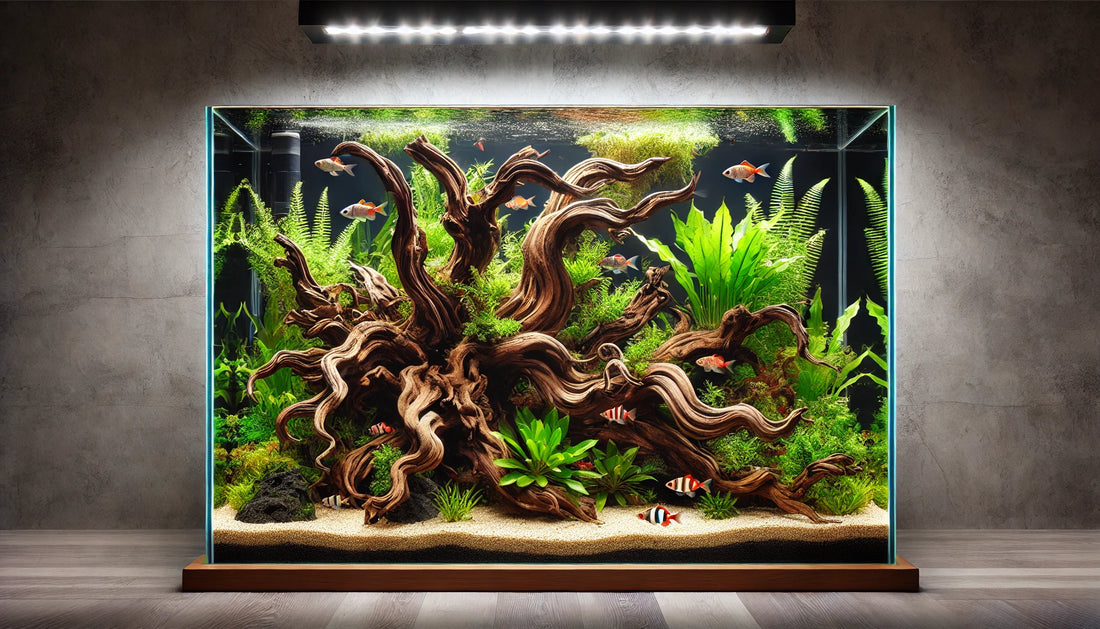Incorporating driftwood into your aquarium not only enhances its aesthetic appeal but also provides numerous benefits for your aquatic life. This guide will walk you through the benefits, selection, preparation, and maintenance of driftwood in aquariums. Additionally, we’ll highlight some top-quality products from Charterhouse Aquatics to help you get started.
Benefits of Driftwood in Aquariums
1. Natural Habitat Simulation Driftwood provides a natural environment for fish, mimicking their native habitat. Species like catfish and loaches love to hide and forage around driftwood, which can help reduce stress.
2. Aesthetic Enhancement Driftwood adds a rustic, natural look to your aquarium, creating a visually stunning centerpiece that can complement live plants and other decorations.
3. Water Chemistry Improvement Certain types of driftwood, like Bogwood, release tannins that slightly lower pH levels, making the water more suitable for soft-water fish.
4. Algae Growth Reduction The presence of tannins also inhibits algae growth, helping to maintain a cleaner tank.
Selecting the Right Driftwood
When choosing driftwood, ensure it's aquarium-safe. Driftwood like Mopani Wood and Redmoor Root are popular choices due to their unique shapes and durability.
Preparing Driftwood for Your Aquarium
1. Cleaning Before adding driftwood to your tank, it's essential to clean it thoroughly to remove any dirt, debris, or pests. Scrub the wood with a brush under running water. Avoid using soap or chemicals.
2. Soaking Soak the driftwood in water for several days to weeks. This helps to saturate the wood and release excess tannins, which can otherwise turn your aquarium water brown. Use a container like the Seachem Tidal 75 Filter to help with this process.
3. Boiling Boiling the driftwood for 1-2 hours can speed up the process of releasing tannins and kill any remaining bacteria or pests. If the wood is too large to boil, soak it in hot water.
Placing Driftwood in Your Aquarium
1. Positioning Place the driftwood in a way that complements the layout of your tank. Consider the flow of water and ensure the wood doesn't obstruct any filtration or heating equipment.
2. Securing Plants Driftwood provides an excellent anchor for plants like Anubias and Java Fern. Use aquarium-safe glue or fishing line to attach the plants.
Maintaining Driftwood in Your Aquarium
1. Regular Cleaning Driftwood may develop biofilm, a slimy layer that’s harmless but can be unsightly. Clean the driftwood during regular tank maintenance by gently scrubbing it with a brush.
2. Monitoring Tannins Even after initial soaking, driftwood can continue to release tannins. Regular water changes using the Python No Spill Clean and Fill help manage tannin levels. Activated carbon in your filter, such as Seachem MatrixCarbon, can also help keep the water clear.
Conclusion
Adding driftwood to your aquarium is a fantastic way to enhance its beauty and create a more natural habitat for your fish. By choosing the right type of driftwood and preparing it correctly, you can enjoy the many benefits it offers. Visit Charterhouse Aquatics to explore our extensive range of driftwood and other aquarium supplies to help you create a stunning and healthy aquatic environment.
For all your aquarium needs, trust Charterhouse Aquatics to provide top-quality products and expert advice. Dive into the world of aquascaping with driftwood and transform your aquarium into a breathtaking underwater paradise.


